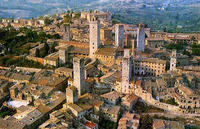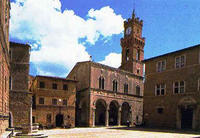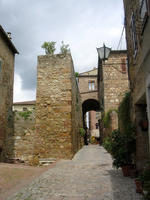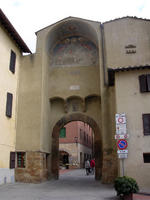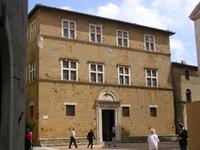You are in: Europe -> Italy -> Historic Centre of t... , and traditional search or Image Gallery will yield results of this site only
Historic Centre of the City of Pienza
| Site number: | 789 |
|
| Type of site: | Cultural | |
| Date: | 1459 | |
| Date of Inscription: | 1996 | |
| Location: | Europe, Italy, Tuscany, Province of Siena | |
Up to 75 images are shown here. Click on each for more details or on Image Gallery for more images.
| Description: | This Tuscan town of Pienza was the first to see Renaissance town-planning theories be carried out, as in 1459 Pope Pius II decided to transform the appearance of his birthplace. He selected architect Bernardo Rossellino for the job, Rossellino hence employed the principles of his mentor, Leon Battista Alberti. This novel vision of urban space was brought to fruition in the marvelous square of Piazza Pio II and its surrounding buildings: the Piccolomini Palace, the Borgia Palace and the cathedral, whose exterior is purely Renaissance whilst its interior is late a Gothic style of south German churches. --WHMNet paraphrase from the description at WHC Site, where additional information is available. | |
| Pienza, a town and commune in the province of Siena, in the Val d'Orcia in Tuscany (central Italy), between the towns of Montepulciano and Montalcino, is the "touchstone of Renaissance urbanism." In 1996, UNESCO declared the town a World Heritage Site, and in 2004 the entire valley, the Val d'Orcia, was included on the list of UNESCO's World Cultural Landscapes. Pienza was rebuilt from a village called Corsignano, which was the birthplace (1405) of Aeneas Silvius Piccolomini (Italian: Enea Silvio Piccolomini), a Renaissance humanist born into an exiled Sienese family, who later became Pope Pius II. Once he became Pope, Piccolomini had the entire village rebuilt as an ideal Renaissance town. Intended as a retreat from Rome, it represents the first application of humanist urban planning concepts, creating an impetus for planning that was adopted in other Italian towns and cities and eventually spread to other European centers. The rebuilding was done by Florentine architect Bernardo Gambarelli (known as Bernardo Rossellino) who may have worked with the humanist and architect Leon Battista Alberti, though there are no documents to prove it for sure. Alberti was in the employ of the Papal Curia at the time and served as an advisor to Pius. Construction started about 1459. Pope Pius II consecrated the Duomo on August 29, 1462, during his long summer visit. His included a detailed description of the structures in his Commentaries, written during the last two years of his life. --Wikipedia. Text is available under the Creative Commons Attribution-ShareAlike License. | ||
| Source: | http://whc.unesco.org/en/list/789 | |
| Reference: | 1. UNESCO World Heritage Center, Site Page. | |







